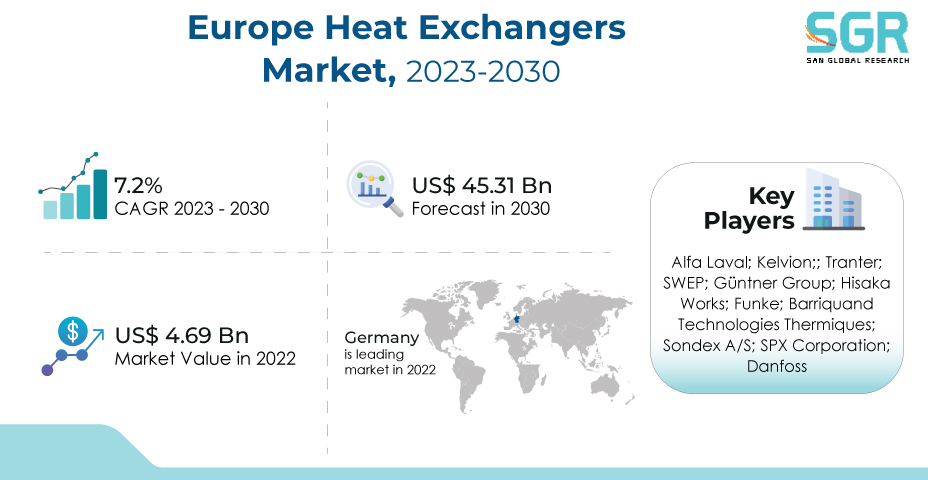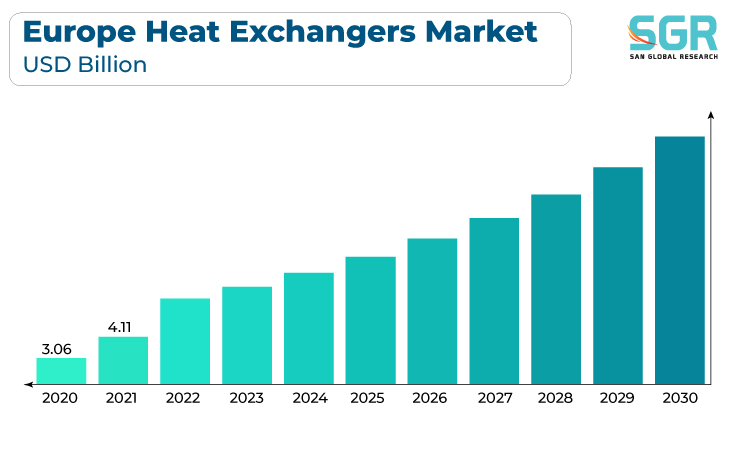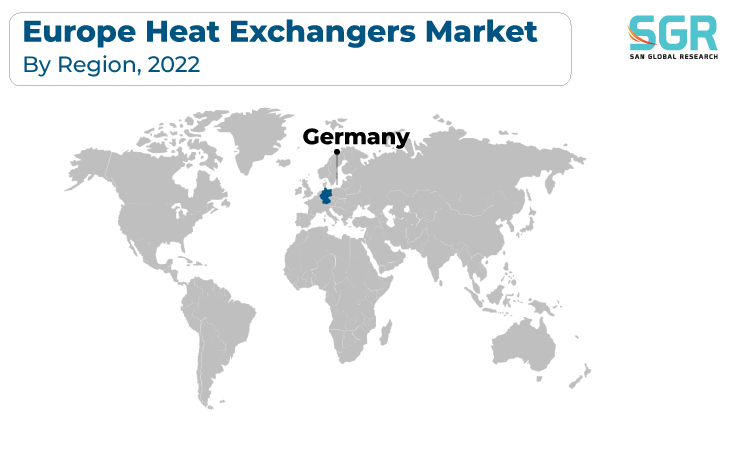Report Overview
The Europe Heat Exchangers Market was valued at 4.69 billion in 2022 and expected to grow at CAGR of 7.2% over forecast period.

Several key factors are driving the Europe heat exchangers market, including an increased emphasis on energy efficiency and sustainability in industries such as HVAC, power generation, and chemical processing. Heat exchangers are critical for recovering and optimizing heat transfer, lowering energy consumption, and lowering greenhouse gas emissions.

The growth of renewable energy sources such as solar and wind power necessitates the use of efficient heat exchangers for energy conversion and storage. Stricter environmental regulations, combined with the need to improve process efficiency and lower operational costs, drive up demand for heat exchangers in Europe, making them an essential component in achieving energy and environmental goals across a variety of industrial sectors.
Product Outlook
Based on Product, the Europe Heat Exchangers Market is segmented in Shell & Tube, Air-Cooled. Shell & Tube segment accounted for largest share in 2022. The robust demand for efficient and versatile heat exchange solutions in various industrial applications such as petrochemicals, HVAC systems, and power generation is driving the shell and tube heat exchangers market. Shell and tube heat exchangers are ideal for high-pressure and high-temperature applications, making them indispensable in the region's energy, chemical, and manufacturing industries. Furthermore, the ongoing emphasis on energy efficiency, combined with stringent environmental regulations, has resulted in a greater need for dependable heat exchangers to optimize heat transfer and reduce energy consumption.

Air-cooled heat exchangers provide efficient cooling while avoiding the use of water, making them particularly useful in areas where water scarcity is a concern. With a growing emphasis on energy efficiency and sustainability, these heat exchangers are critical in optimizing cooling processes in power plants and industrial facilities, reducing water consumption, and improving overall operational efficiency.
End Use Outlook
Based on End Use, Europe Heat Exchangers Market is segmented into oil & gas, power generation, pulp & paper, chemical & petrochemical, food & beverage, HVAC & refrigeration, and others. Chemical & petrochemical accounted for largest share in 2022. The chemical and petrochemical industries are driven primarily by the need for efficient heat transfer solutions in order to optimize processes, reduce energy consumption, and improve safety. Heat exchangers are essential components for controlling temperature in chemical reactions, refining processes, and other industrial processes. Furthermore, the region's emphasis on sustainability and environmental compliance necessitates energy-efficient heat management solutions, and heat exchangers help meet these requirements by reducing emissions and waste.
Heat exchangers are essential for ensuring product quality and safety while also increasing production efficiency and lowering energy consumption. With consumers increasingly seeking convenience and high-quality products, the FMCG industry relies on heat exchangers for pasteurization, sterilization, and temperature control, all of which are critical for preserving and extending product shelf life. Furthermore, the sector's commitment to sustainability and cost-effectiveness highlights the importance of heat exchangers in process optimization, making them a critical driver in Europe's FMCG industry as it continues to innovate and meet market demands.
Country Outlook
Germany has emerged as leading market for Europe Heat Exchangers Market in 2022. Germany places a high priority on reducing energy consumption and greenhouse gas emissions, which has resulted in increased demand for heat exchangers in a variety of industries, including automotive, chemicals, and HVAC systems. Heat exchangers play an important role in recovering waste heat, optimizing energy usage, and improving process efficiency, making them essential in meeting these environmental and energy goals.
Heat exchangers are heavily used in the UK's industrial sectors, such as manufacturing, chemicals, and power generation, to optimize processes, reduce energy consumption, and minimize environmental impacts. Heat exchangers play a critical role in capturing and reusing waste heat, thereby improving sustainability, as the country strives to meet stringent emission reduction targets. Furthermore, the expansion of renewable energy projects, as well as the need for efficient heat transfer in applications such as district heating systems and heat recovery in data centers, drive demand for heat exchangers, positioning them as critical components in the United Kingdom's pursuit of energy efficiency and environmental stewardship.

Recent Key Developments in Europe Heat Exchangers Market
- In July 2023, Equinix partnered with housing company Vonovia, engineering firm AS Enterprise Engineering, and investment advisor and asset manager EB-SIM to build a heating network in the north of Frankfurt Griesheim. Around 1,000 households will be supplied cost-neutrally with excess heat generated by local Equinix data centers beginning in 2025. The heat exchanger will be connected to three different locations (FR4, FR6, and FR8).
- In June 2023, Oerlikon announced manufacturing of heat exchanger for Ariane 6 rocket launcher by signing deal of 900,000 euros. The aluminium parts, to be produced by Oerlikon AM, will act as heat management devices for onboard equipment, enhancing the performance and flexibility of the new launcher
- In June 2023, Danfoss, a Danish manufacturer, increased its brazed-plate heat exchanger production capacity in China and Slovenia. Danfoss also claims to have invested in propane testing facilities in France and to have expanded its R290 microplate brazed plate heat exchanger range.
Europe Heat Exchangers Market Report Scope
| Report Attribute | Details |
| Market Value in 2022 | USD 4.69 Billion |
| Forecast in 2030 | USD 45.31 Billion |
| CAGR | CAGR of 7.2% from 2023 to 2030 |
| Base Year of forecast | 2022 |
Historical |
2018-2021 |
| Units | Revenue in USD Billion and CAGR from 2023 to 2030 |
| Report Coverage | Revenue forecast, Industry outlook, competitive landscape, growth factors, and trends |
| Segments Scope | By Product, By End Use |
| Countries Covered | Germany, United Kingdom, France, Italy, Russia, Spain, Netherlands, Switzerland, Sweden, Poland |
| Key Companies profiled | Alfa Laval; Kelvion;; Tranter; SWEP; Güntner Group; Hisaka Works; Funke; Barriquand Technologies Thermiques; Sondex A/S; SPX Corporation; Danfoss |
Europe Heat Exchangers Market Segmentation
Product Outlook (Revenue, USD Billion, 2018 - 2030)
- Shell & Tube
- Air-Cooled
End Use Outlook (Revenue, USD Billion, 2018 - 2030)
- Oil & gas, power generation
- Pulp & paper
- Chemical & petrochemical
- Food & beverage
- HVAC & refrigeration
- Others
Europe Heat Exchnager Market : By Country
- Germany
- United Kingdom
- France
- Italy
- Russia
- Spain
- Netherlands
- Switzerland
- Sweden
- Poland

 Description
Description
 Table of Content
Table of Content
 Gera Imperium Rise,
Gera Imperium Rise,  +91 9209275355
+91 9209275355


